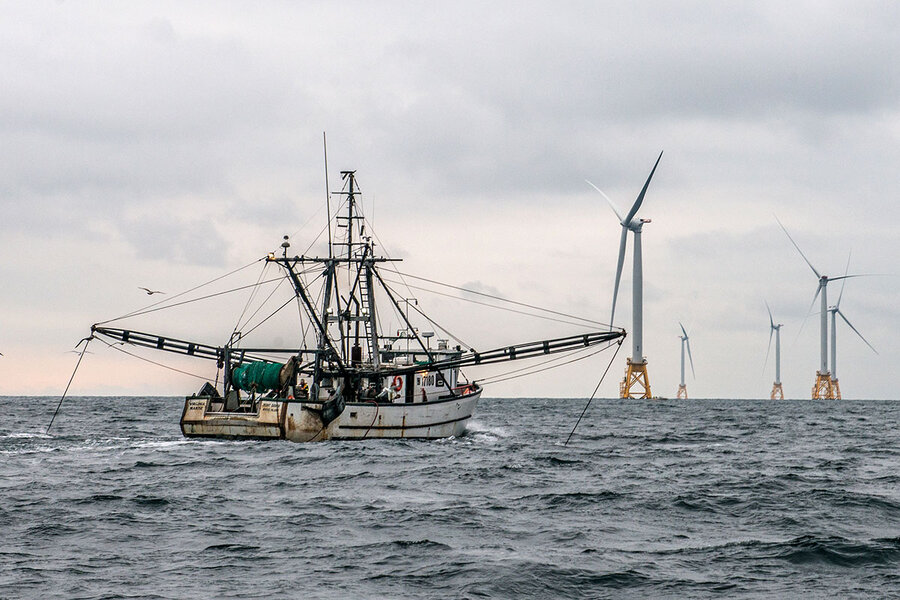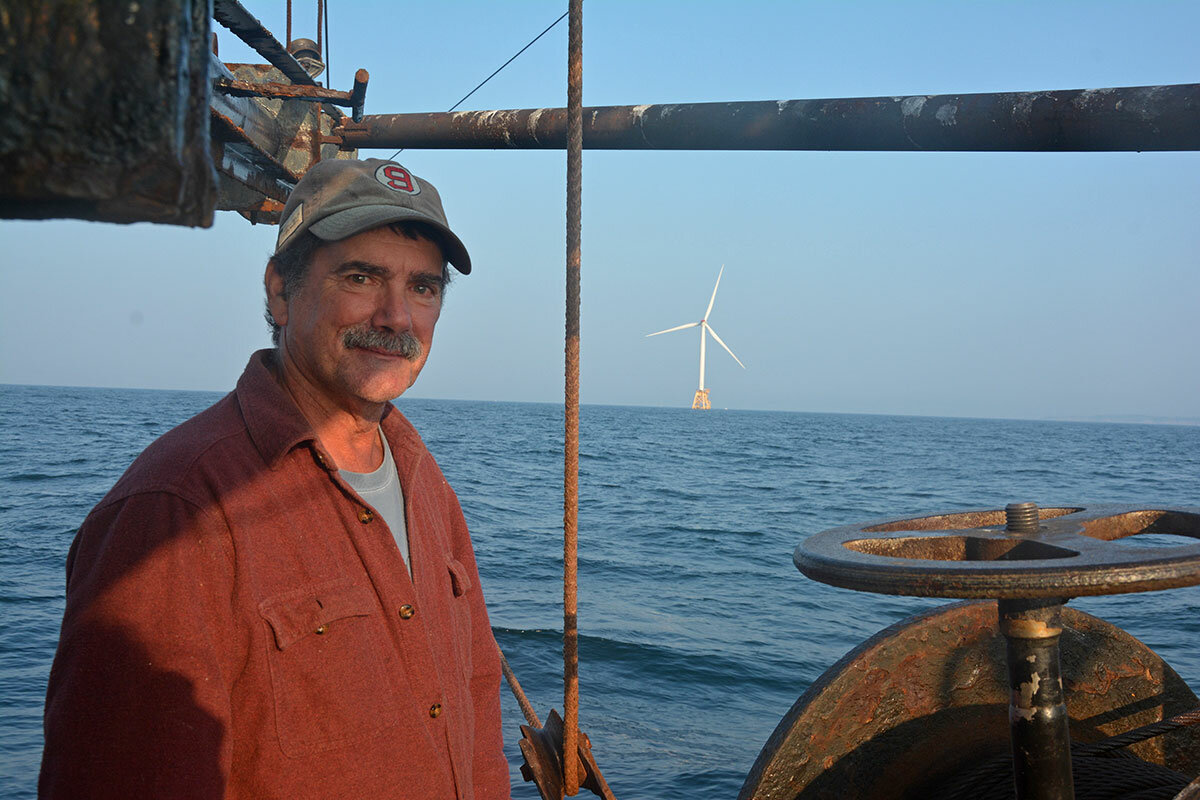Can offshore wind and commercial fishing coexist?
Loading...
| Point Judith, R.I.
The Virginia Marise slides away from the dock into the pitch-black night. At 4 a.m., the only light comes from a flood light illuminating the deck of the boat and a handful of streetlights on land that disappear into the darkness as Captain Rodman Sykes maneuvers his boat out of the harbor, the black sky indistinguishable from the black sea.
This is a familiar scene to fishermen like Mr. Sykes. Commercial fishermen have headed out on these New England waters for some 400 years, casting their lines and nets overboard just as the sun peeks over the horizon. But at daybreak on this August morning, there’s a new sight. As the inky-black night gradually fades into the dim gray pre-dawn light, five red flashing lights appear all in a row on the horizon.
Those lights come from the five turbines making up the United States’ first offshore wind farm – the 30 megawatt Block Island Wind Farm. As the Virginia Marise draws closer, and the sky begins to blush pink, the turbines stand out on the horizon. The blades turn slowly in the slight breeze, generating electricity that flows through a cable buried in the seabed to Rhode Island’s Block Island.
Why We Wrote This
New industries have a way of edging out old ones. As a fledgling offshore wind industry surges to life off New England's coast, fishermen and developers are searching for ways to share the sea.
The turbines and all the hardware that accompanies them spun to life in December 2016. So far, this is the only offshore wind power in the nation, and with just five turbines, it’s a small installation. But that’s soon to change. Massachusetts, Rhode Island, and Connecticut have already selected larger projects which are set to be installed not far from the Block Island Wind Farm. And more are in the development pipeline in New York, New Jersey, and Maryland.
This flurry of activity has sparked agitation among the fishermen who have long been a fixture on the Eastern seaboard. Could fields of turbines disrupt their operations and the resource on which their livelihoods depend? Meetings with developers and permitting officials have been tense and, at times, explosive. A group of fishermen have even sued the federal government for leasing a tract of seafloor south of Long Island to an offshore wind developer.
But despite the hostility, some fishermen have expressed the desire to find a way to share the seas. And that will to find common ground may be the first step toward coexistence.
“We’ve got two renewable resources. One in seafood, and one in wind,” says Eric Hansen, a Massachusetts scallop fisherman. “They shouldn’t have to compete.”
Winds of change
The offshore wind industry may be just getting started in the United States, but in Europe, it’s been around for a few decades. And it isn’t small. As of 2017, 4,149 turbines were connected to the grid across the continent. So some American fishermen have looked to Europe for clues about what might happen as offshore power picks up on this side of the pond.
Mr. Hansen is one of those American fishermen. He traveled to Britain with the Fisheries Survival Fund in June to see the wind farms for himself and to speak with fishermen.
The relationship between Europe’s offshore wind farms and local fishermen varies from country to country, but in some, like Belgium, fishermen are not allowed to enter wind farms. And even in places like Britain where fishermen can still fish among the turbines, Hansen learned that many choose not to, largely for fear of the damage that could result from tangling with the mechanical giants. Other fishermen have had to navigate around large swaths of turbine-filled ocean en route to fishing grounds, adding valuable time to their trips.
But a deeper concern that arose out of Hansen’s trip abroad was that offshore wind development might proceed without input from fishermen, as that is one gripe cited by European fishermen.
In the US, rapid-fire political activity promoting offshore wind power in recent years fuels that fear. In August 2016, Massachusetts Gov. Charlie Baker signed a bill requiring electricity distribution companies to buy long-term contracts for at least 1,600 megawatts of offshore wind power by 2027. This year, three other states – New York, New Jersey, and Connecticut – passed further legislation to promote and mandate offshore wind power. There’s also federal support for offshore wind, from an endorsement by Interior Secretary Ryan Zinke to funding for research and development.
That political will is a boon for clean energy advocates. But to fishermen, it’s overwhelming, especially in southern New England, where projects feeding power to four states are planned for the waters between Block Island and Martha’s Vineyard.
“Everything’s on a fast track,” says Fred Mattera, a Rhode Island commercial fisherman and president of the Commercial Fisheries Research Foundation. “I don’t think anybody – even myself – can comprehend the dramatic change in the landscape.”
In April, with Massachusetts moving quickly toward offshore wind energy, a national coalition of commercial fishing groups wrote a letter to Governor Baker asking state officials to keep the first project smaller than 400 megawatts, proceed slowly, and set up a system for the offshore wind and seafood industries to communicate and exist side by side.
But since then, power utilities in Massachusetts, Rhode Island, Connecticut, and New York have all forged ahead with offshore wind contracts in southern New England waters. If all goes as planned, those projects will add 1490 megawatts of offshore wind power.
“It’s important that we get it right on these next projects,” says Aileen Kenney, senior vice president of development at Deepwater Wind, the developer behind the five-turbine Block Island Wind Farm. Deepwater Wind was awarded all but one of those new contracts. The plan is to scale up slowly, moving next to a 15-turbine project generating power for Long Island, says Ms. Kenney.
Setting precedents
It’s crucial that fishermen are part of the conversation now, before turbines go into the water, Mr. Mattera says. It’s about setting a precedent. What happens now will set the stage for the relationship between the industries going forward. If one developer ignores fisheries’ concerns in favor of profit, he says, others might, too.
“We’re not saying no, we’re not trying to stop it,” Rhode Island lobsterman Lanny Dellinger adds. “We’re trying to have a reasonable outcome in this that allows fisheries to survive.”
The Block Island Wind Farm was a good start, Mr. Dellinger says, thanks to the state’s permitting process. The Rhode Island Ocean Special Area Management Plan (Ocean SAMP) requires extensive stakeholder engagement for any development in state waters, and a Fishermen’s Advisory Board was established to ensure the fishing industry’s voice is heard. Dellinger is the chairman.
“We brought the fishermen in from the very start, and made the developers sit down and work with these guys to work out where they could coexist,” says Grover Fugate, executive director of the state’s Coastal Resources Management Council, which is in charge of the Ocean SAMP implementation.
But the projects currently on the table are all in federal waters, and therefore under federal jurisdiction. At that scale, the voices of individual fishermen and local fishery alliances can be easily missed. State agencies could still influence the permitting process, as federal actions that affect coastal use are required to be consistent with the state’s coastal management program.
But fishermen may now have a stronger voice of their own on the national stage. In June, a group of fishing industry associations and commercial operations came together to form the Responsible Offshore Development Alliance (RODA). The alliance’s outlined goals are to make offshore wind development and fisheries more compatible going forward, and to promote collaborative scientific research on the effects of offshore development on fisheries and fish populations.
Even when channels for inter-industry dialogues are established, finding common ground on specifics might not come easily. It’s tricky for the layout of a wind farm, for example, to be ideal for both industries. To capture the most wind energy, turbines should be organized somewhat randomly, explains Deepwater Wind's Kenney, so turbines don’t block the wind for other turbines. The difference in revenue can be significant, she says. But that doesn’t work so well for fishermen, particularly fishermen who trawl for squid and other fish using nets towed behind their boats.
Getting answers
As the fiery August sun appears over the Virginia Marise, illuminating the haze on the horizon, Captain Sykes and his two crew members drop the massive trawling net into the water. The five turbines turn slowly in the breeze, standing like silent sentinels watching over the dragging operation.
This isn’t an ordinary morning for the fishermen. They trawl for just a fraction of the time they normally would, and after they hoist the net out of the water and dump its wriggly contents out, they step back.
Three scientists step in, picking up fish of all shapes, sizes, and sorts. All the northern sea robins go in one basket, the black sea bass in another; butterfish, squid, scallops, and every kind of flounder each get their own container, too. Then they get counted, weighed, and measured.
Once a month, Sykes takes a break from his typical trawl to bring scientists out on the Virginia Marise to survey the waters around the Block Island Wind Farm and in two nearby control areas. This project started in September 2012, two years before construction began.
A big concern for fishermen is how little is known about how offshore wind farm construction and operation will affect fish populations. So in an attempt to start answering some of those questions, Deepwater Wind commissioned INSPIRE Environmental – an independent research consultant – to work with local fishermen to design and execute a fish survey. That’s why Sykes and the scientists set out to the turbines together.
The process started with “lots and lots of meetings with fishermen,” says Drew Carey, chief executive officer of INSPIRE Environmental. The goal was to make sure the study’s results would have significance for the fishing industry, and that they would trust the data.
That’s why Sykes got involved. “I felt from the start that it was important that one of the Point Judith fishermen should do it,” he says. “The fishermen have more faith in the information we gather ourselves.”
Other preliminary research found a flurry of fish activity around the base of the turbines, suggesting they may serve as artificial reefs. As a result, some recreational fishermen actually seek out the turbines.
But a line of just five turbines will only begin to answer fishermen’s questions. And with dramatic variation in the seafloor and ecosystems from site to site, fishermen have called for more long-term, baseline research before turbines go in so they can better assess changes.
“There are a lot of unknowns that we would like to get some answers to before the whole Eastern seaboard is populated by wind turbines,” Hansen says. “A lot more research needs to be done.”
This story was produced with support from an Energy Foundation grant to cover the environment.









